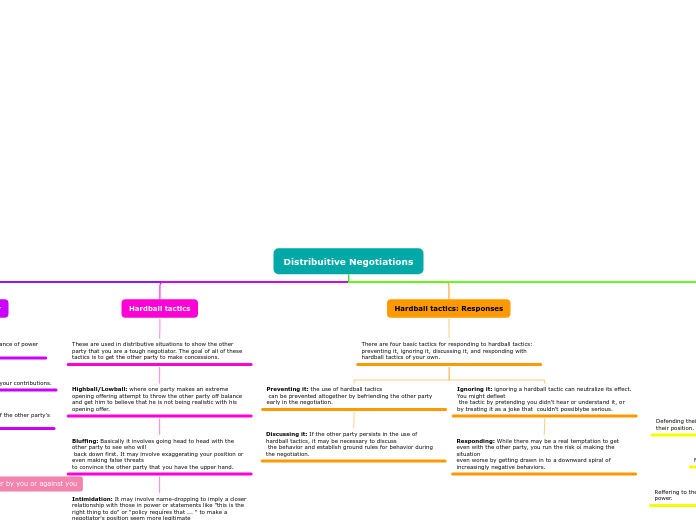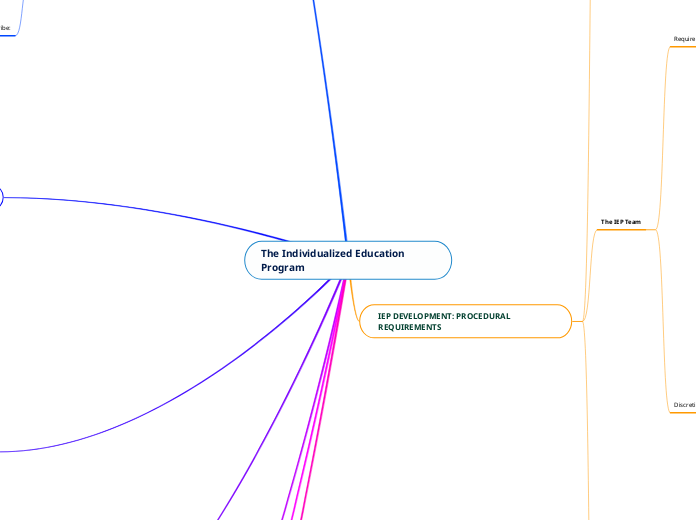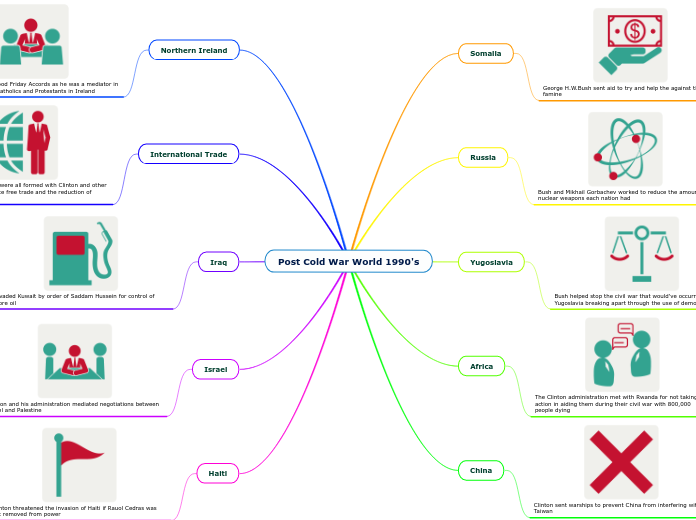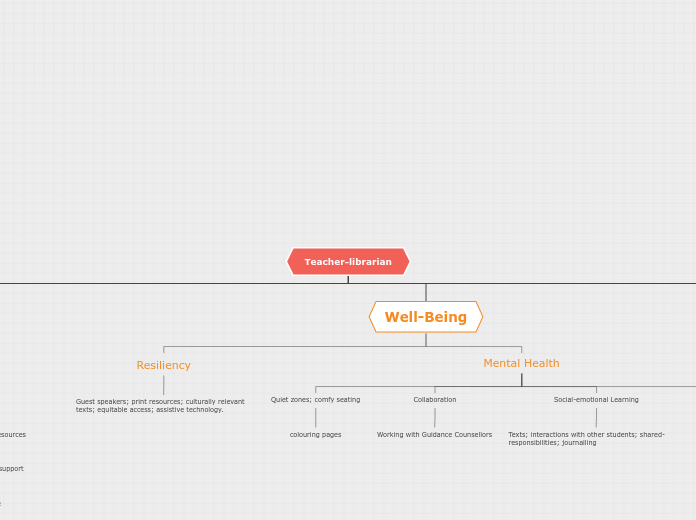Distribuitive Negotiations
Commitment
The final step in any negotiation is obtaining commitment from the parties on all issues involved in the negotiation.
Tentative agreement (TA): is often used to indicate that the parties agree on a particular issue in anticipation of reaching an agreement on all issues involved.
"exploding" offer: where the offer is good only for a limited period of time. The idea is that if one party does not accept the offer, the opportunity is lost.
Breaking off negotiations: occasionally the other party makes a commitment to do something that you don't want him to do, in this case you might simply ignore the threat or try to restate the position in softer, more favorable terms.
A tactic to encourage commitment is to note the similarities between the parties and their needs:
In a labor-management setting, it might involve
a promise of a better working relationship if agreement
is reached.
In a positive light, this may include promises
made to the other party that will provide him value.
Concessions
Are what you give up and are expected in any negotiation.
Negotiatiors establish opening offers with the expectation that it is unlikely that their counterpart will agree to their first offer.
Making concessions goes hand in hand with claiming value and is usually a case of reciprocity in action- giving something with the expectation of getting something in return.
"Winner's curse": if a negotiatior's first offer is immediately accepted, he is often left feeling like he could have done better.
A negotiation skill is knowing how to manage the reciprocity so as to sustain your negotiation strategy, regardless of the other party's approach.
Labors negotiations: is when an employer agrees to raise the pay of employees if the employees agree to pay part of the cost of their medical insurance.
Logrolling: the exchange of support or favors. Offers yield higher profit for the initiator, and higher combined profits for both parties than purely distributive offers.
Claiming value
Negociators use their power and sometimes hardball
tactics to claim value, in other words, to get as much of
the settlement range as possible.
Some of the behaviors negotiators use to claim value include:
Making single-issue offers
Suggesting creative solutions to meet
their own interests.
It is to a negotiator's advantage to be optimistic about what she can obtain in a negotiation.
Defending their arguments to substantiate
their position.
Making threats.
Reffering to the bottom line and their power.
Hardball tactics: Responses
There are four basic tactics for responding to hardball tactics: preventing it, ignoring it, discussing it, and responding with hardball tactics of your own.
Ignoring it: ignoring a hardball tactic can neutralize its effect. You might defleet
the tactic by pretending you didn't hear or understand it, or by treating it as a joke that couldn't possiblybe serious.
Responding: While there may be a real temptation to get even with the other party, you run the risk oí making the situation
even worse by getting drawn in to a downward spiral of increasingly negative behaviors.
Preventing it: the use of hardball tactics
can be prevented altogether by befriending the other party early in the negotiation.
Discussing it: If the other party persists in the use of hardball tactics, it may be necessary to discuss
the behavior and establish ground rules for behavior during the negotiation.
Hardball tactics
These are used in distributive situations to show the other party that you are a tough negotiator. The goal of all of these tactics is to get the other party to make concessions.
Highball/Lowball: where one party makes an extreme opening offering attempt to throw the other party off balance and get him to believe that he is not being realistic with his opening offer.
Bluffing: Basically it involves going head to head with the other party to see who will
back down first. It may involve exaggerating your position or even making false threats
to convince the other party that you have the upper hand.
Intimidation: It may involve name-dropping to imply a closer relationship with those in power or statements like "this is the right thing to do" or "policy requíres that ... " to make a negotiator's position seem more legitimate
Bogey: involves including issues in your opening offer that are really not important to you, but give you something to trade later.
Nibble: involves asking for additional small things after negotiation has begun or even reached tentative agreement on the main issues.
Good cop/bad cop: requires
two negotiators, it is rooted in the scenario of two police officers trying to convince a suspeet to confess.
Overwhelming the other party with information: It involves providing the other party with so much information that he is left feeling distracted and overwhelmed so he will agree to what you want just to avoid wading through all the information.
Tactics to change power
There are four basic tactics for changing the balance of power in negotiation:
lncrease the value of your contributions.
Dccrease the value of the other party's
contributions
Increase the quality of
your BATNA.
Decrease the quahty of
the other party's BATNA.
Leverage power
In negotiation, leverage is the power that one side of a negotiation has to influence the other side to move closer to their negotiating position. A party's leverage is based on its ability to award benefits or impose costs on the other side.
Types of leverage
Positive leverage is a negotiator's ability to provide things that his or her opponent wants. Positive leverage is based in the ability of one party to satisfy the needs of another party. The power from positive leverage comes from the opportunity to provide or withhold the needed item or action.
Negative leverage is a threat-based form of leverage that represents one side's ability to make the other side worse off. The power of negative leverage relies on loss aversion. Because potential losses are seen as worse than equivalent gains, negative leverage can be very powerful.
Normative leverage relies on using social standards or norms to encourage consensus. It draws from the principle of consistency, using such standards and norms as well as coherent positioning to advance or protect a position.
Mixed motive
Any negotiation process is a situation of mixed motives, where you want to both compete and cooperate, the competition to obtain the best results for ourselves or the organization we represent, and the cooperation to establish an appropriate climate and continue to maintain relationships with The other part.
Information Sharing in Distribuitive Negotiations
In integrative negotiations, information sharing is a crucial
component in the creating value stage where it is necessary to identify altematives for meeting the needs of both parties.
Distributive Negotiator
Would not: Ask questions about the other party's needs or put effort into building a relationship. Try to combine various issues in an attempt to meet the needs of the other party.
Will: Engage in negative
behaviors such as displaying negative reactions, noting differences between the parties' proposals, attacking theother party's arguments, and asking for the other
party's bottom line.
Distributive Bargaining
Competitive bargaining strategy: one party gains only if the other party loses something. It's used as a negotiation strategy to distribute fixed resources.
Power tactics
There are 9 organizational power tactics. These tactics are ways in which individuals translate power bases into specific actions.
1. Rational persuasion. A tactic that is used to try and convince someone with a valid reason, rational logic, or realistic facts.
2. Inspirational appeals. A tactic that builds enthusiasm by appealing to emotions, ideas and/or values.
3. Consultation. A tactic that focuses on getting others to participate in the planning process, making decisions, and encourage changes.
4. Ingratiation. A tactic that emphasizes on getting someone in a good mood prior to making a request.
5. Personal appeals. A tactic that refers to friendship and loyalty while making a request.
6. Exchange. A tactic that suggests that making express or implied promises and trading favours.
7. Coalition tactics. Refers to a tactic that prescribes getting others to support your effort to persuade someone.
8. Pressure. A tactic that focuses on demanding compliance or using intimidation or threats.
9. Legitimating tactics. This tactic suggests that basing a request on one’s authority or right, organizational rules or policies, or express or implied support from superiors, is a best.









